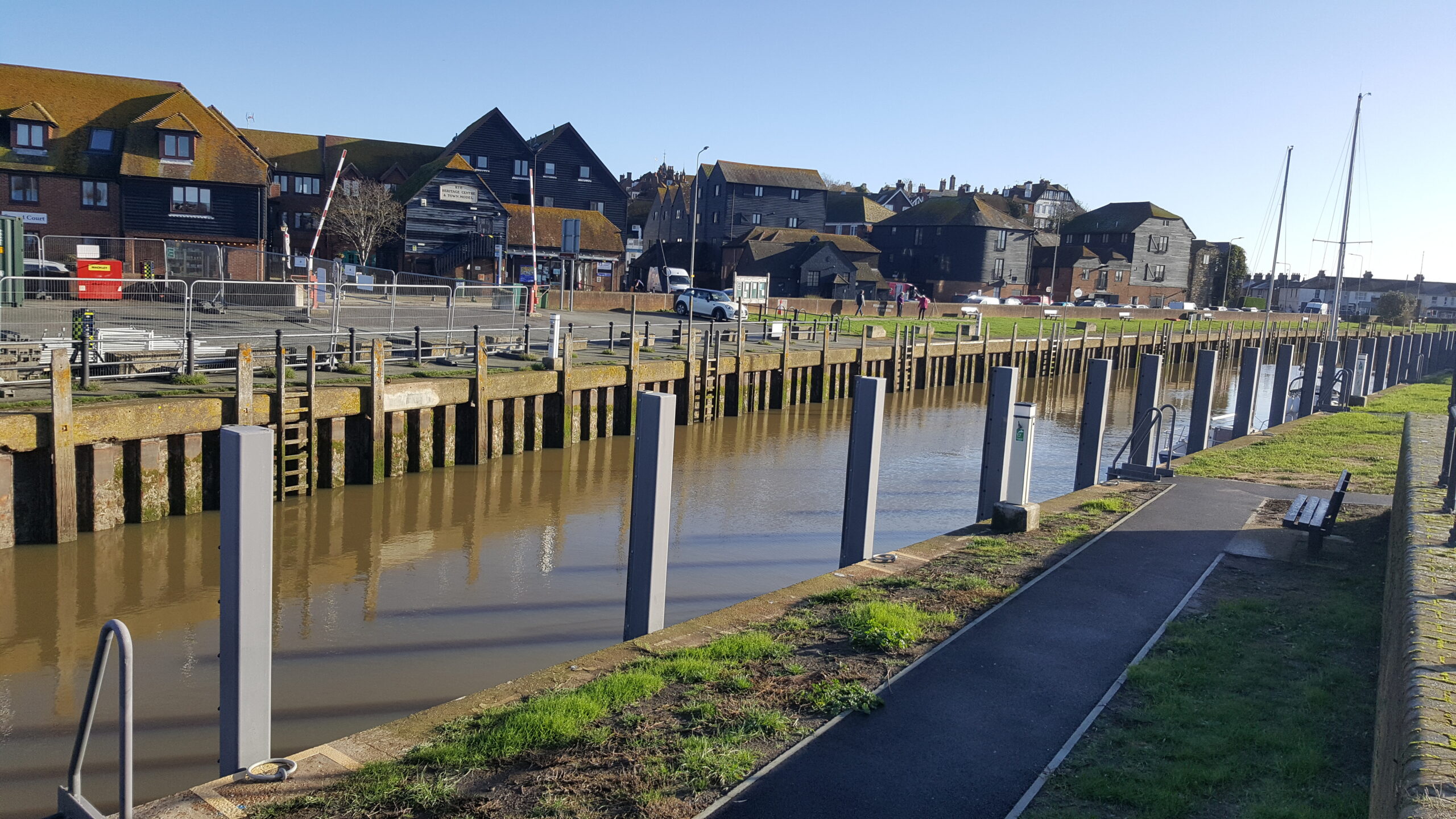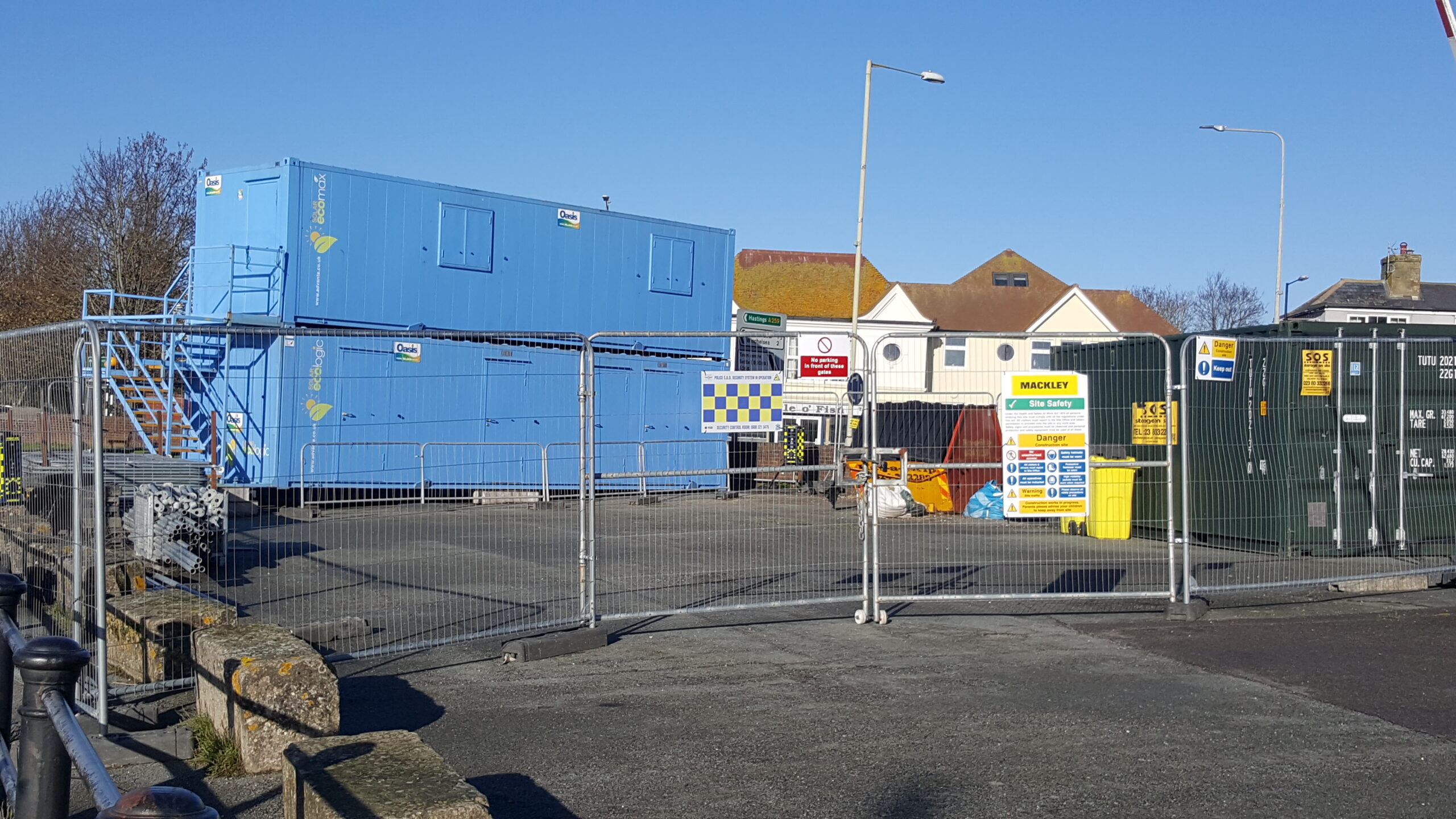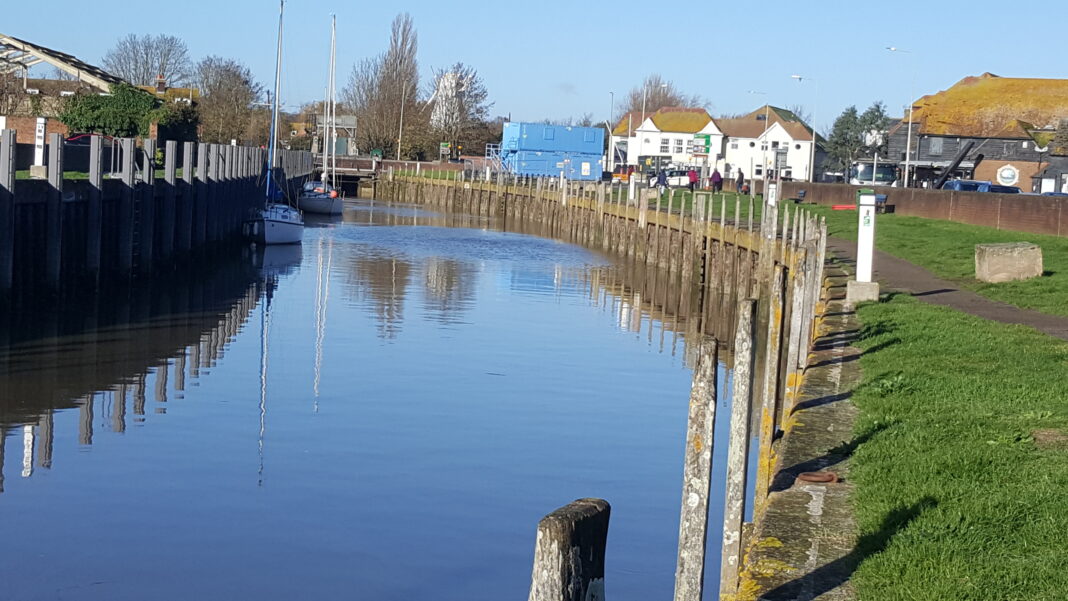Last week Rye News published a letter from a reader complaining about the Environment Agency containers still occupying the small car park – or more accurately, motor cycle park – at the top end of Strand Quay, and asking when were they going to be removed.
As it turns out, this is not a case of the EA being lazy and not bothering to remove their gear, but the work that has been going on at the quay is not yet complete.
Many readers will have noticed the refurbishment of access ladders and other sections on the Winchelsea Road side and this part of the job is now finished. However, as part of a general upgrade scheme to improve facilities and attract more visiting yachts, it is intended to install a floating pontoon along the length of the Strand side for both visitors and yachts permanently moored in Rye. As these pontoons will go up and down with the tide it will remove the current death-defying climb up a vertical and sometimes slippery ladder to get off or onto a moored boat at low tide.

It was intended that this section of the work would follow immediately on from the work on the opposite side, however objections raised by Natural England have been responsible for the delays in getting started.
The cause of the problem has been that the new pontoon will restrict the area for wading birds to paddle about at low tide. There are, of course, several hundred, if not thousand acres of mud along the rivers Tillingham, Brede and Rother, to say nothing of the Rye Harbour Nature Reserve, but apparently this particular piece of low tide mud is important to them.
The need to resolve this and satisfy the naturalist lobby has delayed completion of the work by many months. However an arrangement has now been reached to provide an alternative wading area and thereby enable construction of the pontoon and access way to be re-scheduled. At the time of writing, the actual start date is not known, however it is intended that work will be complete and construction materials and equipment removed by March 2024, in time for the visitor season whether by land or sea.

Some readers will undoubtedly remember how busy the quay was with marine traffic and visiting yachts some years ago. However, since the arrival of the marina at Eastbourne with its access at virtually all states of the tide (albeit with up to a 30 minute wait for the entrance lock at low tide), and its first class facilities for visitors, the numbers of yachts visiting Rye have inevitably declined.
We do, however, have many obvious advantages that the somewhat impersonal environment of Eastbourne Marina does not, and it is hoped that the improvements to the quay, including modest upgrades to the boat owners’ shore services (and here we must also include the excellent self-service laundry facilities recently installed at Jempson’s. Anyone who has ever spent time on a small yacht will know how important this is!) will help to demonstrate that Rye is very much open for business to its marine visitors.
Image Credits: John Minter .




Maybe if the proposed marina had been built on the brown field site on harbour road,and lock gates introduced at Rock Channel, it may have made Rye on par with Eastbourne marina, but as usual anything beneficial to the town,like also the proposed bypass,all get shelved at the end of the day, Strand Quay will never be a visiting place for yachts,when other marinas, have all the facilities to accommodate them.
I’m a little confused by this – is John Minter saying that the EA have spent considerable time and money improving access ladders etc on the Winchelsea Road side of the Quay which are now deemed unsuitable for leisure yachts to use because owners might slip on the ladders so now they are going to put floating pontoons on the Strand side to alleviate the problem ? Seems that the first part of the work was a waste of money then ?
A couple of small points about the environment agency shed’s occupying the bike park on the quay, one is that it’s not a bike park and the other is that they just happen to own the land.
If floating pontoons rely on water, surely the pontoons will sit on the mud at low tide, thus requiring the ladders that are slippery .
My understanding is that access to the pontoons will be via a ramp at one end which will move with the pontoon. This is the usual system where tidal movement of a pontoon is a factor
Work on the Winchelsea Road side of the Quay was part of a much needed update of the whole Quay. The retaining piles were replaced because they needed replacing regardless of other work being done and the ladders because access to water level will always needed on both sides of the Quay. The pontoons are being constructed to provide better and more user-friendly access for visitors as well as resident boat owners and to encourage more yachtsmen to come to Rye. This will also enable more boats than at present to be moored at any one time. With these improvements together with ongoing flood prevention measures, an enormous amount of money is currently being spent by the EA on our town. Let’s not knock it.
Thanks for the further clarification- makes a little more sense now. I’m not knocking anything that offers genuine improvement to Rye and its facilities- just didn’t read logically in the original article IMHO
What a pity when it was mooted a few years ago to put lockgates at the junction of the rivers at Rock Channel,this wasn’t implemented, would have saved a lot of expense at strand Quay,cleared up the eyesore when the river is down,and made the surroundings of the Quay, more like a proper marina
John Tolhurst suggest keeping water in the Strand at all times, so my question is where would the water from the Tillingham go if the Strand was locked off, you can’t make a flood relief drain which is what the Strand is into a marina.
Two weeks ago you were moaning about flooding on Tilling Green and now you’re suggesting stopping the main route to stop it happening.
The Tillingham, Brede and upper reaches of the Rother must be allowed to drain to the sea or flooding will become even more of a problem.
Regarding the Tillingham river and its ability to drain to the sea.When we were younger ,we used to fish in the river, one method of catching fish was to wait for the river to run.
The flood gates at the strand were opened allowing the river to escape to the sea,you could drop your line in with a suitable float,worm for bait and let the current take over, I think that this method was called Trotting,but not certain.This was great fun, I think that because of that if you fished near to the Windmill end of the river you could catch eels,very rarely small flat fish and rumoured a sea trout as it made the water a little saline .If you fished nearer the source of the river end it was freshwater fish,even brown trout,the river at that end was beautiful and clear in those days,hope it still is now.